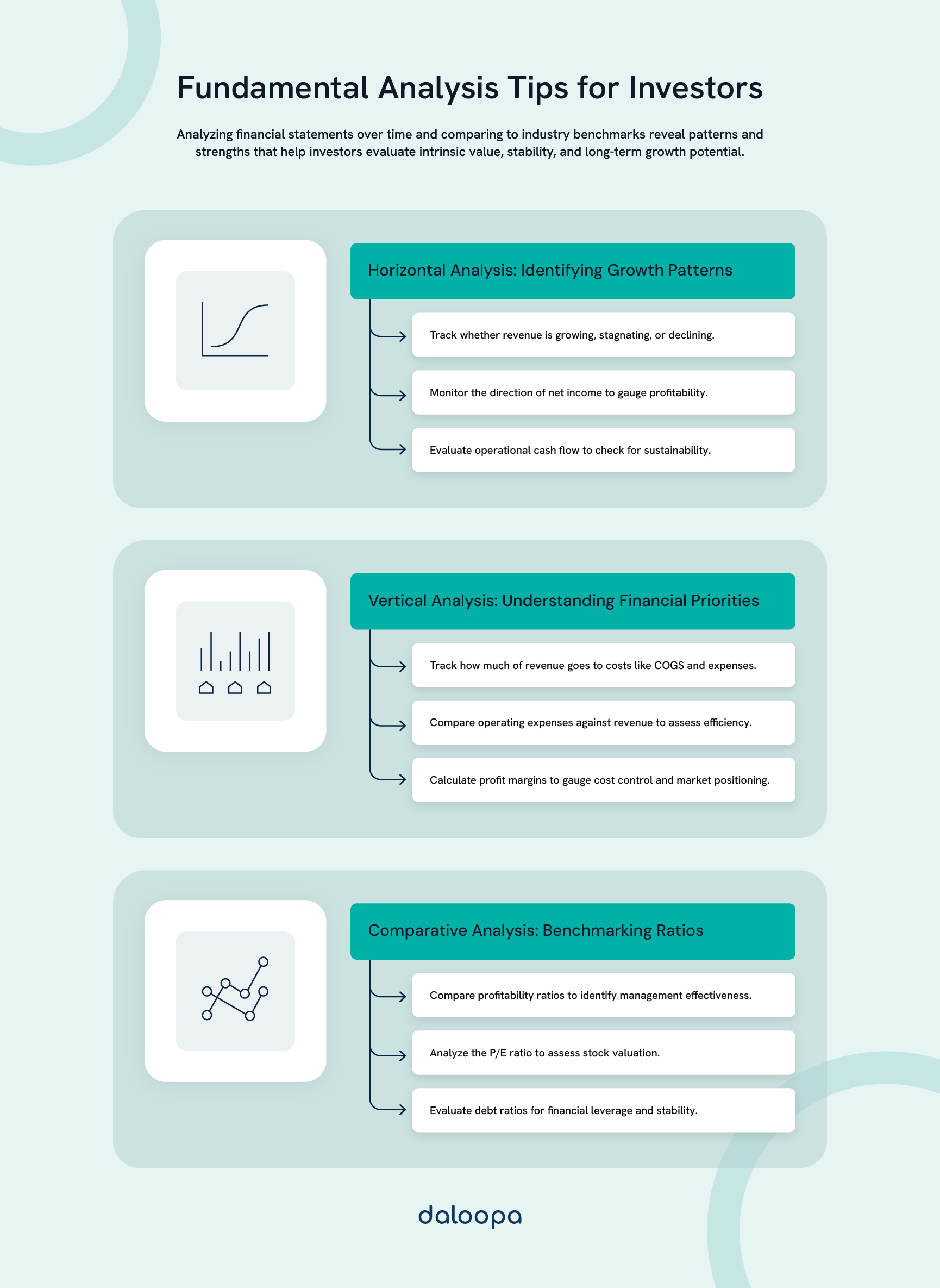Investors consider financial statements in fundamental analysis essential for gaining comprehensive insights into a company’s financial condition and performance. Financial statements provide detailed quantitative data on revenue, expenses, assets, liabilities, and cash flows, enabling investors to evaluate profitability, efficiency, liquidity, and overall financial stability.
By offering a standardized, regulated look at a company’s financial position, financial statements in fundamental analysis enable investors to make informed comparisons within industries or sectors, spot trends, recognize potential red flags, and gauge management’s effectiveness in resource utilization and shareholder value generation.
Key Takeaways
- Financial statements offer critical data for evaluating a company’s financial health.
- Analyzing financial statements helps investors determine intrinsic value and future potential.
- Financial statements in fundamental analysis help identify market positioning and competitive advantages.
Financial Statements in Fundamental Analysis Overview
Financial statements in fundamental analysis are crucial for evaluating a company’s financial health. The main financial documents include the income statement, balance sheet, and cash flow statement, each providing unique insights. Investors who rely solely on surface-level analysis often miss underlying trends that only detailed financial statements can reveal.
The income statement outlines revenue, expenses, and profitability over a period, helping assess earnings growth and profit margins. The income statement allows investors to observe revenue consistency, cost management, and profitability trends over various periods, giving a deeper understanding of the company’s operational efficiency.
The balance sheet presents a snapshot of assets, liabilities, and equity, allowing investors to gauge financial stability and solvency. A strong balance sheet with a healthy asset-to-liability ratio indicates financial flexibility and potential for expansion without excessive risk.
The cash flow statement monitors cash movements, highlighting how effectively a company manages funds and offering a more in-depth look into earnings quality and sustainability.
Financial statement analysis includes methods such as:
- Horizontal analysis: Reviewing data over time for trend identification.
- Vertical analysis: Comparing line items relative to a base figure.
- Comparative Ratios: Calculating and analyzing financial metrics to evaluate a company’s performance relative to its peers or industry benchmarks.
These techniques help pinpoint trends, strengths, and weaknesses in a company’s financials. By incorporating financial statements in fundamental analysis with industry trends and economic conditions, investors can gain a comprehensive view of a company’s intrinsic value, equipping investors to foresee potential financial setbacks and make proactive decisions to manage risk.

The Importance Of Financial Statements in Fundamental Analysis
Financial statements in fundamental analysis form the foundation for evaluating financial health and future potential. By thoroughly analyzing these financial statements in detail, investors can assess a company’s current status and can signal potential areas for growth or concern.
Providing Insight Into Financial Health
Financial statements in fundamental analysis offer clear visibility into profitability, liquidity, and solvency. Income statements showcase revenue trends and margins, revealing the firm’s ability to generate earnings. The balance sheet highlights assets, liabilities, and equity, portraying financial stability. For instance, an investor who notices a growing disparity between current assets and liabilities may interpret it as a sign of potential liquidity challenges.
Cash flow statements demonstrate how a business handles cash. Cash flow statements are particularly informative when comparing cash generated by operations versus net income, revealing how much of reported earnings get converted into cash. Analyzing these documents over time reveals patterns and trends in performance, empowering investors to make data-driven assessments.
Evaluating Intrinsic Value
Investors rely on financial statements to calculate ratios and metrics for intrinsic value assessment. Key figures like price-to-earnings (P/E) ratios, return on equity (ROE), and debt-to-equity ratios provide valuable insights into a company’s financial performance. These metrics become even more telling when benchmarked against peers in the same sector, allowing for meaningful comparisons and informed investment choices.
Such metrics facilitate comparative analysis within industries and sectors. Merging this quantitative data with qualitative elements like management strength and market position helps create a well-rounded view of a company’s value, supporting accurate predictions of future performance and potential stock price trends and helping investors distinguish between fundamentally strong and overvalued stocks.
Key Components Of Financial Statements
Financial statements in fundamental analysis provide a wealth of information for evaluating a company’s worth and potential, offering a window into both present and projected financial stability.
Balance Sheet Analysis
The balance sheet offers a financial status snapshot detailing assets, liabilities, and shareholder equity. Assets may include cash, inventory, and property, while liabilities cover debts and obligations. Shareholder equity reflects net worth. The balance between assets and liabilities and trends over several reporting periods often indicates the company’s strategic direction and financial health.
Analyzing balance sheets helps assess liquidity and solvency. Current and debt-to-equity ratios indicate the ability to meet obligations and overall stability. Companies with a strong balance between assets and liabilities signal financial health and growth potential. Identifying trends in these numbers is vital for a clear financial picture and spotting early warning signs of financial trouble.
Income Statement Insights
The income statement, or profit and loss statement, highlights financial performance over time, detailing revenues, expenses, and net income. It reflects how efficiently a company turns revenue into profit and identifies both strengths and vulnerabilities in a company’s operations.
Critical elements include:
- Gross profit
- Operating profit
- Net income
These figures enable the calculation of ratios like gross margin and net profit margin. Comparing these to industry benchmarks and historical data helps evaluate the company’s competitive position and financial health.
Revenue growth and expense management play a pivotal role. Positive trends often point to solid business fundamentals. However, sudden increases in expenses without corresponding revenue growth can highlight inefficiencies or potential risks.
Cash Flow Statement Examination
The cash flow statement tracks cash in and outflows across:
- Operating activities
- Investing activities
- Financing activities
The focus is on operating cash flow, indicating how well core business operations generate cash, often providing a clearer financial picture than net income alone, as it is not influenced by non-cash items like depreciation or amortization.
Free cash flow, derived by subtracting capital expenditures from operating cash flow, is a key indicator of financial flexibility. Sustained positive free cash flow suggests a capacity for growth, dividends, or debt repayment.
Financial Ratios And Metrics
Ratios and metrics from financial statements in fundamental analysis offer insights into a company’s financial health and performance. They provide a quantitative way to evaluate profitability, efficiency, and potential growth.
Understanding Key Ratios
Profitability ratios gauge earnings generation, including profit margin, return on equity (ROE), and return on assets (ROA). The profit margin shows revenue-to-profit conversion efficiency. ROE assesses how well shareholder equity generates profits, while ROA measures asset utilization, becoming more meaningful when evaluated over multiple periods to determine trends.
Liquidity ratios, such as the quick ratio, indicate short-term stability. Efficiency ratios like asset turnover and receivables turnover measure data management effectiveness. Analyzing these ratios can reveal how adeptly a company handles its day-to-day operations and manages assets to generate revenue.
Assessing Future Growth Potential
Growth potential analysis involves metrics like earnings per share (EPS) and revenue growth. The price-to-earnings (P/E) ratio helps identify stock valuation relative to earnings, guiding investment decisions. High P/E ratios can signal growth expectations or potential overvaluation, depending on the context.
Dividend-focused investors look at dividend yield and dividends per share for return insights. The interest coverage ratio is vital for understanding debt repayment capability and influencing growth prospects. A higher interest coverage ratio typically reflects a stronger financial position.
Incorporating Financial Statements in Fundamental Analysis
Integrating financial statements in fundamental analysis data with other tools enables investors to assess value and make informed decisions comprehensively.
Top-Down And Bottom-Up Approaches
Fundamental analysis involves top-down and bottom-up approaches. Top-down starts with macroeconomic factors and industry trends, narrowing to specific companies. Analyzing GDP, interest rates, and sector data helps find promising areas, followed by examining financial statements in fundamental analysis for top performers.
Bottom-up focuses on individual companies, leveraging financial statement analysis to derive metrics like P/E, debt-to-equity, and ROE. Combining both approaches uncovers opportunities aligning with company strengths and market conditions. Investors gain a comprehensive understanding of both macroeconomic forces and company-specific details.
Making Informed Investment Decisions
Comparing intrinsic value to market price helps identify overvalued or undervalued stocks, revealing trends in revenue, profit margins, and cash flow. Consistent improvements often signal solid financial health and potential. Comparing ratios to industry norms positions the company competitively and informs strategic decisions.
Building Confidence In Investment Strategies
Long-term investment success is rooted in a consistent, data-driven financial statement analysis examining past performance and future potential.
Key Factors in Building Investment Confidence
Analyzing revenue growth, profit margins, debt levels, and cash flow over time helps identify stable companies. Indicators like return on equity (ROE) and free cash flow ensure that a company manages its finances efficiently. Additionally, understanding how external economic factors affect a company allows investors to place financial data in context.
Reducing Risk Through Analysis
Before they escalate, financial statement analysis reduces risk by identifying potential red flags, such as declining revenue or increasing debt levels. Reviewing balance sheets, income, and cash flow statements thoroughly ensures investors make informed decisions backed by comprehensive data.
Automation Tools To Upgrade Your Financial Analysis Potential
Modern tools have enhanced how we conduct financial analysis. Automation allows for more efficient and accurate assessments.
Leveraging Technology in Analysis
Excel remains vital, offering functions and add-ins for valuation models, forecasts, and ratio calculations. It helps handle large datasets and visualize trends with ease. Specialized financial platforms provide features like real-time data integration and automated ratio calculations, flagging potential concerns.
Machine learning algorithms analyze vast data sets, spotting trends human analysts might miss, including social sentiment. Natural language processing extracts data from filings and reports, informing analysts of significant updates.
Cloud-based tools support collaborative work and real-time data sharing, ensuring up-to-date analysis across teams. Automation complements human judgment, streamlining analysis to focus on strategic insights.
AI-powered Technology
AI-driven tools, like those offered by Daloopa, transform traditional financial modeling by automating repetitive tasks, reducing errors, and enabling real-time insights. For instance, advanced machine learning algorithms can analyze vast datasets, such as market trends or macroeconomic indicators, with unparalleled speed and accuracy.
These tools outperform manual processes, eliminating data entry errors and significantly reducing the time required to generate reports.
Natural Language Processing (NLP)
Natural Language Processing (NLP) also plays a pivotal role, enabling tools to extract and synthesize information from complex filings, news releases, and earnings reports, ensuring analysts stay informed on critical updates. With automated systems, financial teams can continuously monitor vast datasets without sacrificing precision or oversight, making it easier to identify patterns and predict market shifts.
By leveraging AI’s data-processing abilities, firms gain deeper insights into company performance and broader economic and industry trends, allowing for more informed and timely decision-making.
See How Daloopa Transforms Financial Statements in Fundamental Analysis
Daloopa exemplifies these advancements by offering AI-powered solutions that streamline the financial modeling process, providing analysts with accurate, up-to-date financial statements in fundamental analysis and insights with unprecedented efficiency. Request a demo to see how Daloopa can elevate your fundamental analysis, helping investors access reliable data quickly and make more informed decisions.



